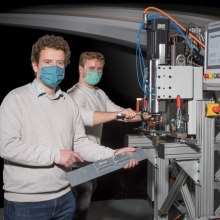If light metals such as aluminum are used in vehicle body construction, the vehicle weight can be significantly reduced, so that the vehicles will consume less fuel and therefore emit less CO2. However, the joining of such components using conventional welding techniques is not achieved satisfactorily. In this case, so-called friction stir welding has process engineering advantages. But the required process equipment is very expensive and inflexible. Martin Werz, Head of Joining Technology and Additive Manufacturing at the Materials Testing Institute (MPA) of the University of Stuttgart, and his team have now developed a robot-operated welding gun - the so-called “Steppwelder” - that enables flexible use and can be integrated cost-effectively into vehicle production.
“Friction stir welding was developed in England in the 1990s; here, the materials to be joined are not joined by melting, but by a kind of kneading,” Martin Werz explains. The joining technology has many advantages: no tendency for hot cracking in aluminum alloys that are difficult or impossible to weld, mixed joints are possible (e.g. of aluminum and steel), and there is almost no heat development. It is a green technology, as only little energy is required and no additional materials. In addition, no hazardous by-products such as welding fumes and spatter are produced.
“But despite its advantages, friction stir welding is underrepresented because, up to now, there has been no flexible, economical process equipment available,” says Werz. The welding engineer and his team have now designed the Steppwelder. This robot system with a welding gun can be easily integrated into the production line. It has the same size as other welding and joining guns used in vehicle manufacture.
In this way, it is possible to also join curved workpieces. The gun allows any positioning in three-dimensional space and can make continuous weld joints. “The joints need to be extremely strong,” Werz emphasizes. In contrast to a long, continuous seam that would require large, expensive machines, in friction stir welding using the Steppwelder, several short seams that provide very high strength are welded intermittently, which results in a “stitch” look. Leak-tight seams are also possible.
From patent application to the demonstrator
In 2018, the team filed a patent application for the process. However, in order to be able to demonstrate the process to various industrial companies, a suitable demonstrator was also very important. For this purpose, the research team successfully acquired a total of EUR 78,000 from the university’s own fund to support technology transfer. With the money, they were able to develop and build the demonstrator. A number of students, including Dominik Walz, have also explored the process in their student research projects and master’s theses. Today, Dominik Walz is a research assistant at the MPA. He and Martin Werz visited several companies where they presented the Steppwelder and components that were joined together using the new welding tool. “Before we had the demonstrator, the companies only shrugged at the idea,” Werz recalls, “but after presenting the first parts welded together with the Steppwelder, they were impressed.”
Funding
The project received EUR 78,000 from the university’s internal fund to support knowledge and technology transfer. The year of proposal was 2018.
Further information on funding by the university
Renowned companies such as Porsche, Daimler, and Audi as well as ARENA2036, material suppliers, and equipment manufacturers signed a letter of intent. In addition, the companies gave the scientists the following tasks: shorten the process time and further improve accessibility to the component. Martin Werz and his team now want to implement this by spring and design the Steppwelder 2.0. The letter of intent is a prerequisite for EUR 1.22 million of funding, which the MPA scientists, in cooperation with the Institute for Control Engineering of Machine Tools and Manufacturing Units, want to acquire through the VIP+ funding program of the Federal Ministry of Education and Research. Another funding request was made with the participation of the Institute for Metal Forming Technology.





